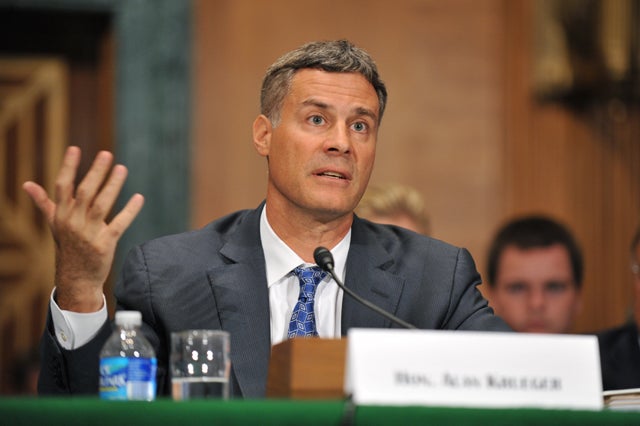Liberals Laud Alan Krueger’s Fatally Flawed Minimum Wage Study
Lachlan Markay /
Alan Krueger, President Obama’s nominee as chair of the White House Council on Economic Advisors, received accolades from liberals yesterday for his stances on a number of major economic issues, including his support for a cap and trade regime, and value added tax, and the Cash for Clunkers program.
But few of his contributions to economics are more widely hailed by the left than a single study he published with David Card in 1993 which purported to show that a higher minimum wage does not necessarily lead to greater unemployment, as many economists claimed. The study examined the effects of New Jersey’s 1992 minimum wage hike on employment in the fast food industry, using neighboring Pennsylvania as a control group.
The study found that employment at the New Jersey fast food restaurants actually increased at a greater rate than those in Pennsylvania after the former increased its minimum wage. Those findings were touted far and wide by liberal politicians, including Bill Clinton’s Labor Secretary Robert Reich and the late Sen. Ted Kennedy (D-MA), as evidence of the beneficent economic effects of a higher minimum wage.
But subsequent reviews of the study showed fatal flaws that undermined its findings. In 1996, a review of the study by the Employment Policies Institute found that the data sets Krueger and Card used were so badly flawed that “no credible conclusions can be drawn from the report.” Specifically, the study found, “the data set used in the New Jersey study bears no relation to numbers drawn from payroll records of the restaurants the New Jersey study claims to cover.”
Rather than look at those payroll records, Krueger and Card called fast food managers in New Jersey and Pennsylvania to ask about changes in employment at their restaurants. But not only did the data they obtained inaccurately reflect changes in fast food employment in the two states, according to the EPI, about a third of their data points got the direction of hiring wrong – that is, the data showed restaurants reduced employment when they actually increased it, and vice versa, during the period measured.
The actual payroll records told a very different story. When David Neumark and William Wascher re-evaluated the study, they found that data collected using those records “lead to the opposite conclusion from that reached by” Card and Krueger.
“[E]stimates based on the payroll data,” wrote Neumark and Wascher, “suggest that the New Jersey minimum wage increase led to a 4.6 percent decrease in employment in New Jersey relative to the Pennsylvania control group.” In other words, the New Jersey/Pennsylvania case study supports the basic economic notion that increasing the cost of hiring a worker will generally lead to fewer workers hired.
Subsequent studies on the effects of the minimum wage on employment and income lent weight to that position. Another Neumark-Wascher study found “’no compelling evidence’ that minimum wages help in the fight against poverty,” according to the National Bureau of Economic Research Digest. “A higher minimum wage…generates tradeoffs with respect to the incomes of poor and low-income families. Some families gain and others lose.”
A study conducted by Neumark and Olena Nizalova in 2004 found that a higher minimum wage can even have adverse on the individual workers (rather than simply on a business or economy as a whole). “[E]ven as individuals reach their late 20’s,” they wrote, “they work less and earn less the longer they were exposed to a higher minimum wage, especially as a teenager.”
A 1999 examination of French and American minimum wage laws by John Abowd, Francis Kramarz, and David Margolis found that they were “associated with mild employment effects in general and very strong effects on workers employed at the minimum wage… In the United States, a decrease in the real minimum wage of 1% increases the probability that a man (woman) employed at the minimum wage came from unemployment in the previous year by 0.4% (1.6%).”

